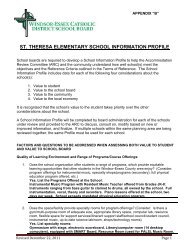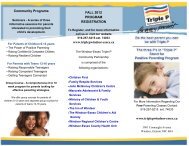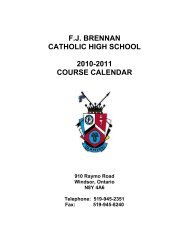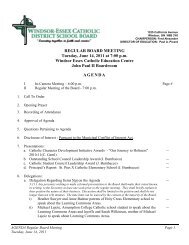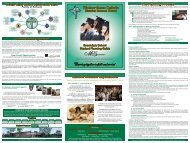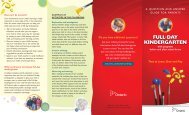OFIP 2 - Windsor-Essex Catholic District School Board
OFIP 2 - Windsor-Essex Catholic District School Board
OFIP 2 - Windsor-Essex Catholic District School Board
Create successful ePaper yourself
Turn your PDF publications into a flip-book with our unique Google optimized e-Paper software.
2008 Special Education Plan Amendments Page 47 of 264LEARNING SUPPORT SERVICES1325 California Avenue<strong>Windsor</strong>, ON N9B 3Y6CHAIRPERSON: John MacriDIRECTOR OF EDUCATION: Joseph BerthiaumeTelephone: (519) 253-2481 FAX: (519) 253-0620OPA Project Summary & GoalsAlthough we have always had a vision of what it is we would like to accomplish using theOPA project funds, the means by which we were to achieve our goals had yet to be clearlyarticulated in June 2007. Concerns were expressed at the monitoring meeting in May thatour project goals may be too ambitious given our current resources and staffing levels. Ourstory is one of being in the right place at the right time, and having input from the rightpeople. The history and philosophy of this board has set the stage for the success of thisproject.The <strong>Windsor</strong>-<strong>Essex</strong> <strong>Catholic</strong> <strong>District</strong> <strong>School</strong> <strong>Board</strong> embraces an inclusive philosophy andsubscribes to the tenets of Education for All. The sheer number of Learning SupportServices Teachers (LSSTs) attests to a commitment to supporting children with diverseneeds within the classroom setting. With this as our infrastructure, we intend to shape ourprimary Special Education services to conform to an RTI model. Although the psychologicalassessment is important in this model, it is no longer used to determine eligibility or access.Demonstrated need, in the sense that a child is not progressing in response to high qualityinstruction (Tier 1), is sufficient grounds for supplementary intervention or access toresources and services.Tier 1 in an RTI model is the standard curriculum or the base level of service delivery fromwhich most students in the classroom are expected to benefit. The PALS reading programhas been chosen as our supplementary intervention – Tier 2, if you will. This is aclassroom-based intervention that meets the needs of all learners and is consistent with theMinistry’s mission of “closing the gap and raising the bar”. The selection of this particularprogram is the result of the input and direction of Drs. Marcia Barnes and Lesly Wade-Wooley, whose contribution to this project has been pivotal to its success thus far.Knowing that there is a group of students on our waitlists who need not have been therehad we intervened early on (some 70% according to the literature), the focus of our OPAplan has been to implement a pilot reading intervention/prevention program as a means ofreducing the numbers on our waitlists. Literacy is being targeted, as reading problems arethe primary presenting reason for referral. Our goal is to demonstrate that such a programhas the twin virtues of reducing reading problems and pressure on the diagnostic system(that is, psychology). Although this won’t have an immediate impact on waitlists, it will overthe longer term as the absolute number of referrals decline (this is where the sustainabilitypart comes in). Furthermore, we were advised to model the intervention and assessmentportions of the project in a way that is as close as possible to what would happen when theproject is scaled-up to all schools in the board.It is anticipated that there will be a group of students who will be “resistors”; they will notbenefit from instruction provided in Tiers 1 and 2. Our goal is to be able to use existingresources wisely by targeting those children who fail to respond to evidence basedinterventions (see below). Our plan now includes adding a Tier 3 intervention, namely the“Learning together in faith and service”




